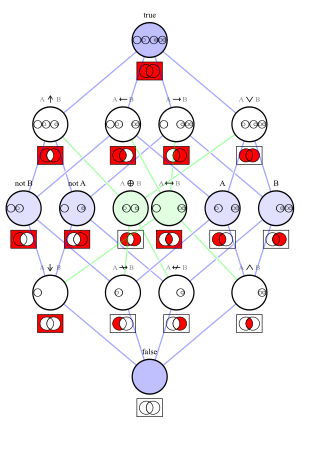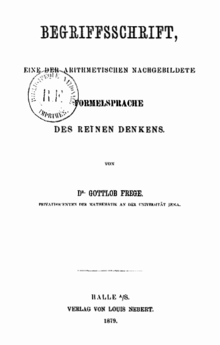First-order logic—also known as predicate logic, quantificational logic, and first-order predicate calculus—is a collection of formal systems used in mathematics, philosophy, linguistics, and computer science. First-order logic uses quantified variables over non-logical objects, and allows the use of sentences that contain variables, so that rather than propositions such as "Socrates is a man", one can have expressions in the form "there exists x such that x is Socrates and x is a man", where "there exists" is a quantifier, while x is a variable. This distinguishes it from propositional logic, which does not use quantifiers or relations; in this sense, propositional logic is the foundation of first-order logic.

In logic, a logical connective is a logical constant. Connectives can be used to connect logical formulas. For instance in the syntax of propositional logic, the binary connective can be used to join the two atomic formulas and , rendering the complex formula .
The propositional calculus is a branch of logic. It is also called propositional logic, statement logic, sentential calculus, sentential logic, or sometimes zeroth-order logic. It deals with propositions and relations between propositions, including the construction of arguments based on them. Compound propositions are formed by connecting propositions by logical connectives representing the truth functions of conjunction, disjunction, implication, equivalence, and negation. Some sources include other connectives, as in the table below.
In logic, proof by contradiction is a form of proof that establishes the truth or the validity of a proposition, by showing that assuming the proposition to be false leads to a contradiction. Although it is quite freely used in mathematical proofs, not every school of mathematical thought accepts this kind of nonconstructive proof as universally valid.

In propositional logic and Boolean algebra, De Morgan's laws, also known as De Morgan's theorem, are a pair of transformation rules that are both valid rules of inference. They are named after Augustus De Morgan, a 19th-century British mathematician. The rules allow the expression of conjunctions and disjunctions purely in terms of each other via negation.
In classical deductive logic, a consistent theory is one that does not lead to a logical contradiction. The lack of contradiction can be defined in either semantic or syntactic terms. The semantic definition states that a theory is consistent if it has a model, i.e., there exists an interpretation under which all formulas in the theory are true. This is the sense used in traditional Aristotelian logic, although in contemporary mathematical logic the term satisfiable is used instead. The syntactic definition states a theory is consistent if there is no formula such that both and its negation are elements of the set of consequences of . Let be a set of closed sentences and the set of closed sentences provable from under some formal deductive system. The set of axioms is consistent when there is no formula such that and .
In mathematical logic, a universal quantification is a type of quantifier, a logical constant which is interpreted as "given any", "for all", or "for any". It expresses that a predicate can be satisfied by every member of a domain of discourse. In other words, it is the predication of a property or relation to every member of the domain. It asserts that a predicate within the scope of a universal quantifier is true of every value of a predicate variable.
Relevance logic, also called relevant logic, is a kind of non-classical logic requiring the antecedent and consequent of implications to be relevantly related. They may be viewed as a family of substructural or modal logics. It is generally, but not universally, called relevant logic by British and, especially, Australian logicians, and relevance logic by American logicians.
In mathematical logic, sequent calculus is a style of formal logical argumentation in which every line of a proof is a conditional tautology instead of an unconditional tautology. Each conditional tautology is inferred from other conditional tautologies on earlier lines in a formal argument according to rules and procedures of inference, giving a better approximation to the natural style of deduction used by mathematicians than to David Hilbert's earlier style of formal logic, in which every line was an unconditional tautology. More subtle distinctions may exist; for example, propositions may implicitly depend upon non-logical axioms. In that case, sequents signify conditional theorems in a first-order language rather than conditional tautologies.
In propositional logic, double negation is the theorem that states that "If a statement is true, then it is not the case that the statement is not true." This is expressed by saying that a proposition A is logically equivalent to not (not-A), or by the formula A ≡ ~(~A) where the sign ≡ expresses logical equivalence and the sign ~ expresses negation.
In mathematical logic and automated theorem proving, resolution is a rule of inference leading to a refutation-complete theorem-proving technique for sentences in propositional logic and first-order logic. For propositional logic, systematically applying the resolution rule acts as a decision procedure for formula unsatisfiability, solving the Boolean satisfiability problem. For first-order logic, resolution can be used as the basis for a semi-algorithm for the unsatisfiability problem of first-order logic, providing a more practical method than one following from Gödel's completeness theorem.
In mathematical logic, a tautology is a formula or assertion that is true in every possible interpretation. An example is "x=y or x≠y". Similarly, "either the ball is green, or the ball is not green" is always true, regardless of the colour of the ball.
In metalogic and metamathematics, Frege's theorem is a metatheorem that states that the Peano axioms of arithmetic can be derived in second-order logic from Hume's principle. It was first proven, informally, by Gottlob Frege in his 1884 Die Grundlagen der Arithmetik and proven more formally in his 1893 Grundgesetze der Arithmetik I. The theorem was re-discovered by Crispin Wright in the early 1980s and has since been the focus of significant work. It is at the core of the philosophy of mathematics known as neo-logicism.
In mathematical logic and computer science the symbol ⊢ has taken the name turnstile because of its resemblance to a typical turnstile if viewed from above. It is also referred to as tee and is often read as "yields", "proves", "satisfies" or "entails".
In logic, especially mathematical logic, a Hilbert system, sometimes called Hilbert calculus, Hilbert-style deductive system or Hilbert–Ackermann system, is a type of system of formal deduction attributed to Gottlob Frege and David Hilbert. These deductive systems are most often studied for first-order logic, but are of interest for other logics as well.
In mathematical logic, predicate functor logic (PFL) is one of several ways to express first-order logic by purely algebraic means, i.e., without quantified variables. PFL employs a small number of algebraic devices called predicate functors that operate on terms to yield terms. PFL is mostly the invention of the logician and philosopher Willard Quine.
In mathematical logic, the ancestral relation of a binary relation R is its transitive closure, however defined in a different way, see below.
The mathematical concept of a function dates from the 17th century in connection with the development of the calculus; for example, the slope of a graph at a point was regarded as a function of the x-coordinate of the point. Functions were not explicitly considered in antiquity, but some precursors of the concept can perhaps be seen in the work of medieval philosophers and mathematicians such as Oresme.
In logic, a quantifier is an operator that specifies how many individuals in the domain of discourse satisfy an open formula. For instance, the universal quantifier in the first order formula expresses that everything in the domain satisfies the property denoted by . On the other hand, the existential quantifier in the formula expresses that there exists something in the domain which satisfies that property. A formula where a quantifier takes widest scope is called a quantified formula. A quantified formula must contain a bound variable and a subformula specifying a property of the referent of that variable.


































